VOTED TOP EYE CARE PRACTITIONER IN LAKE COUNTRY
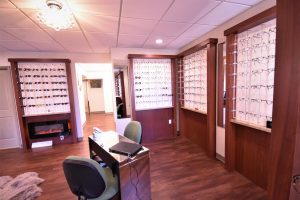
Age-Related Macular Degeneration (ARMD)

ARMD is a disease of your “seeing cells”—your retina. The part of your retina responsible for central vision is called your macula. It is most sensitive to detail, and also most susceptible to damage. Anyone can develop ARMD at any age, but it is most common after the age of 50. At Theia Vision Care™ we perform a detailed fundus exam, which includes digital imaging of the back of the eye for best detection. We also educate you with regard to lifestyle and health changes to decrease your chances of disease occurrence and progression.
Glaucoma

Glaucoma is a painless, progressive disease that steals your peripheral or “side” vision, and whatever vision you have lost is permanent. Usually, glaucoma is caused by a painless rise in the fluid pressure inside your eye, which damages your optic nerve at the back of the eye. However, some people can develop glaucoma even though they have normal eye pressure. Other types of glaucoma can also occur due to diabetes, strokes, inflammation, or trauma. As the optic nerve loses nerve fibers, you lose your peripheral vision, causing “tunnel vision”. If glaucoma is left untreated or undetected, even your central vision can disappear, causing you to be left completely blind. There is no cure for glaucoma, however, if detected early, most patients with glaucoma can preserve all of their vision for their whole lives, with treatments aimed at lowering the intraocular pressure in the eye. At Theia Vision Care™, we have the latest technology to help detect, treat, and monitor glaucomatous changes.
Retinal Detachment

Flashes, floaters, or a curtain or veil blocking a part of your vision are usually the first symptoms to occur when someone is experiencing a retinal detachment. A retinal detachment is a sudden, painless loss of vision, but if detected early enough, a high percentage of patients can be treated and vision can be restored. Only a dilated eye exam can provide the eye doctor with a thorough enough look inside the retina to ensure you are not at risk of developing a retinal detachment. The edges of your retina are the thinnest and most susceptible to breaks or tears (think of stretching saran-wrap too much!), so if we do not dilate your eyes, we will never detect those tiny changes. At Theia Vision Care™, we dilate your eyes to get a thorough look at every part of your retina and if we see any risks of a retinal detachment, we can refer you for prompt treatment.
Presbyopia Diagnosis, Treatment, and Reassurance

Presbyopia is the scientific term given for people who can no longer focus on things up close. This condition is caused by the aging process. When we are younger, the lens of the eye is flexible and changes its shape in order to focus up close – this process is called “accommodation.” As we age, the lens becomes progressively more rigid and loses its ability to accommodate.
Presbyopia happens in every single person eventually, and is not a disease. Eventually, our eyes cannot focus as well on small print, and from the age of about 40 to 60, our reading or near vision slowly gets worse, whether we wear glasses or not! Most people wake up one morning and realize “I can’t see my phone!” … It’s true, it can happen this fast, but the good news is, glasses with you correct prescription will help!
People who are naturally nearsighted (see clearly up close but not out far), have a built-in near prescription, so for them, they can actually take their distance glasses off to read, but for a lot of patients (both nearsighted and farsighted), progressive addition lenses (no-line multifocal), are still the best option so that they don’t have to keep putting on and taking off their glasses to go between seeing far and near.
Computer Vision Syndrome

Computer Vision Syndrome (CVS) is one of the most common conditions today thanks to all of the computer, phone, and tablet use we all do, 24/7! CVS is so common that almost 90% of people have it! CVS comes with symptoms such as decreased or blurred vision, fatigue, burning or stinging eyes, sensitivity to light, headaches, and back and neck pain. Luckily, there are several things that we can do here at Theia Vision Care™ to help prevent CVS and maximize your comfort while on digital devices. If you are experiencing any of these symptoms regularly, schedule an appointment today!
Myopia (nearsightedness)
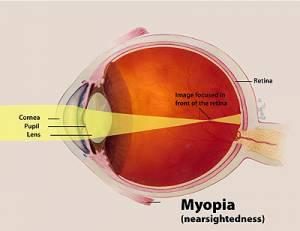
Myopia is the most common refractive error in the world, and has become even more prevalent with all of the close work we do on computers, tablets, and cell phones. When someone is myopic or nearsighted, light that hits their cornea (front of the eye) focuses in front of the retina, making them blurry at distance without their glasses or contacts. Individuals who are nearsighted need corrective eyewear to help them see far away things like driving, TV, sports games, etc. Nearsighted individuals are the best candidates for LASIK and Corneal Refractive Therapy (CRT).
Hyperopia (farsightedness)
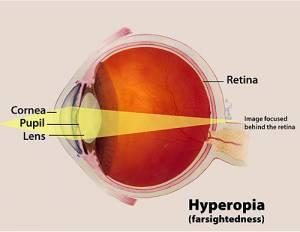
Hyperopia is the refractive error that allows people to see far away objects more clearly than close objects. In hyperopic eyes, the cornea focuses light behind the retina, which can make things difficult to see up close. Individuals who are farsighted benefit from near vision glasses. Sometimes, however, individuals can have such a high prescription that they cannot even see far away without glasses either!
Astigmatism
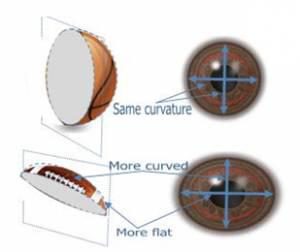
Unlike myopia and hyperopia, where the cornea is perfectly spherical and curved equally like a basketball, astigmatism is a refractive error in which the cornea focuses light at two different points on the retina, and the cornea is more football-shaped. Essentially, since each point needs to be corrected, individuals with astigmatism need two prescriptions for that one As a result of astigmatism, vision for both near and far objects appears blurry or distorted. Contrary to popular belief, most patients with astigmatism can successfully wear contact lenses, as technologies are always improving! These contacts are called “toric” lenses.
Keratoconus
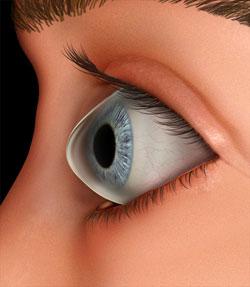
Keratoconus is an eye condition in which the normally round cornea progressively thins causing a cone-like bulge to develop. This results in significant visual impairment. Keratoconus usually starts developing in young individuals around puberty, and the cause is still unknown. In the early stages, it can be treated with soft or hard contact lenses, but if keratoconus progresses too much, the cornea can rupture, and the patient will need a corneal transplant. A promising option for individuals with keratoconus is called corneal collagen cross-linking, in which riboflavin (Vitamin B2), is administered to the cornea in regular intervals with UV light to strengthen the cornea and halt the progression of thinning.
Strabismus

Strabismus is an eye condition in which the eyes are not aligned properly, causing them to “look” in different directions and not work as a team. Most people think of strabismus as a “cross-eye,” but the eyes don’t always turn in, they can drift outwards too! The eye turn can be intermittent, showing up only when the eyes are tired, or it can be constant, which can cause amblyopia (“lazy eye”). Sometimes, both eyes will alternate, but if the eyes are not pointing in the same direction, the one that is not pointed straight is usually “shut off,” which means the patient is only using one eye. Usually, strabismus occurs in young children, but it can also be caused suddenly from trauma, uncontrolled diabetes and hypertension, or a brain aneurysm!
Amblyopia
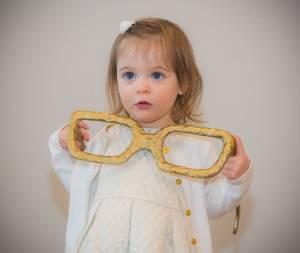
Amblyopia, also known as “lazy eye”, the leading cause of vision loss in kids. It is a condition in which one or both eyes has poor vision and cannot reach 20/20 because of an eye turn or high prescription that was never corrected at a young enough age (usually before age 12). This happens because the connections from the eye to the brain cannot form if a child’s vision is not corrected early enough. Unlike strabismus, amblyopia does not look different—there is no eye turn. Some kids do not know that one eye can’t see well, so if your child has not had an eye exam yet, it is essential to have their eyes checked before they start kindergarten, to catch amblyopia early. Amblyopia is a very treatable condition in kids younger than 12 years old, but every year after age 12, it becomes more difficult to improve vision, and the child will grow up using only one eye. If several months of full-time-wear of glasses do not improve the amblyopia, patching the good eye for around 2 to 6 hours each day forces the weaker eye to work, and the brain connections develop and allow vision to improve! But don’t worry—we won’t make your child wear a patch at school.
Diabetic Retinopathy
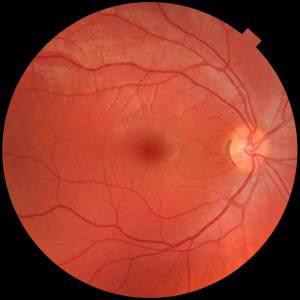
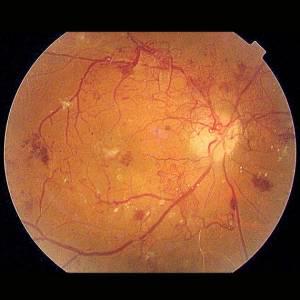
Diabetes is the number one cause of blindness in working-age individuals.
Diabetic retinopathy is a set of complications that can occur in the retina (the seeing cells of the eye) due to elevated blood sugar. If your diabetes is not well-controlled through diet, exercise, or medication, the blood vessels entire body become leaky. The eye is the only place in the body that we can non-invasively see your blood vessels, and if we find that your blood vessels are leaking, blood and fluid can damage the retina and entire body. If advanced enough, diabetic retinopathy can decrease your vision and even cause blindness. If your eyes are showing advanced complications from diabetes, this also means that blood vessels throughout your whole body are leaking and can be damaging other major organs. Diabetics should have a yearly dilated eye exam to monitor for any changes related to diabetes.
